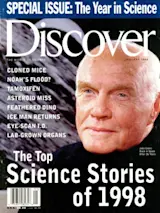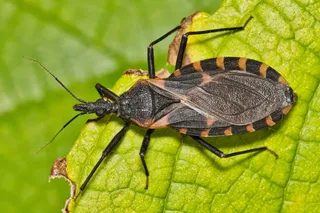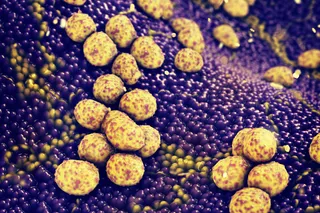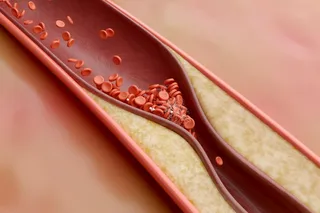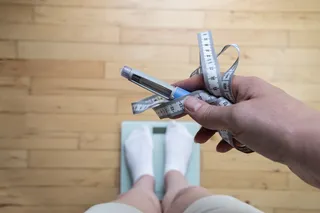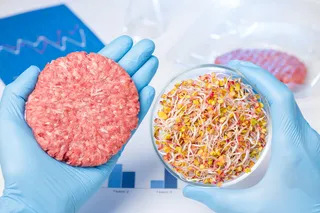A tick doesn't look like trouble--until you come down with Lyme disease. The tick-borne infection sickens more than 10,000 people each year, and without early antibiotic treatment it can progress from a mild malaise to arthritis, heart problems, and even facial paralysis. In the past, the best defenses against Lyme disease were bug repellent, tucked-in clothing, and vigilant checking for the ticks that transmit the disease-causing spirochete, Borrelia burgdorferi. But this past year two companies, SmithKline Beecham and Pasteur Merieux Connaught, reported successful human trials of Lyme disease vaccines. Both are made from a bacterial surface protein that stimulates antibody production. When a tick bites a vaccinated person, it sucks in antibodies that inactivate bacteria in the tick's gut. The hope is that any B. burgdorferi the tick is carrying will be disabled before they can make their way into the person's bloodstream.
To achieve immunity, people need booster shots after six months and, most likely, annual vaccinations. Tick checks, however, are still necessary because the antibodies work only in the tick gut--they won't protect you if tick-borne pathogens slip into your blood. As of mid-November, the vaccines were awaiting FDA approval. Says Phillip Baker, the program officer for Lyme disease at the National Institute of Allergy and Infectious Diseases, "I suspect that after they've been used for two or three years, we're going to see a big drop-off in the number of cases."
=========================================================
Birth Order The traditional method of baby making offers a 50-50 chance of having a girl. Boys and girls both inherit an X chromosome from Mom, but Dad can contribute an X chromosome, in which case the baby will be a girl, or a Y chromosome, resulting in a boy. If, however, you could separate Dad's X-bearing sperm from his Y-bearing sperm, you could increase the odds of conceiving a girl. And that is what researchers at the Genetics and IVF Institute in Fairfax, Virginia, did. In September they announced a sperm-sorting technique that almost guarantees that a girl will be conceived.
X chromosomes tend to carry a bit more DNA--2.8 percent more--than Y chromosomes, and the new technique cleverly highlights that difference by labeling sperm DNA with a dye that glows in the light of a laser. The labeled sperm are then sorted by glow: the bigger the glow, the better the chance that the sperm harbors a longer chromosome (presumably X). If the selected sperm make the grade, they are flushed into the woman's uterus or used to fertilize eggs in vitro. In a small trial, sperm selected to produce girls created pregnancies of the desired sex more than 90 percent of the time. But the technique for selecting sperm bearing the Y chromosome is far less discriminating. Only 65 percent of the sperm selected for the Y chromosome are likely to harbor it. (The institute has not yet released data on pregnancy results for couples using Y-sorted sperm.)
Although sperm sorting is not foolproof, it will help families avoid bearing boys at risk for so-called sex-linked genetic diseases (such as hemophilia), which are caused by mutations on the X chromosome. (If the mother has a flawed X chromosome, selecting sperm that carry the father's healthy X chromosome--thus producing a girl--will help reduce the chance of bearing a child with an X-linked defect.) And it may appeal to any couple who want more control over the sex of their offspring. Indeed, 90 percent of the couples participating in the institute's trial already had two or three children and wanted to balance the number of sons and daughters. But the cost of sorting sperm and flushing them into the uterus--at $1,500 for the sorting procedure and $1,000 for the insemination, with no guarantee of pregnancy--will limit the procedure's use in family balancing to determined, well-heeled parents. And some biologists fear that the method--which has so far produced some 400 healthy animals and, as of September, 11 babies--has not been sufficiently tested for long-term safety. --Sarah Richardson
=========================================================
Forever Young Last year it was cloning. This year's blockbuster in molecular sleight of hand was announced in November, and it opens the door to some of the most far-out scenarios of biology. Two labs--working on privately funded research--reported that they had isolated human embryonic stem cells, the primordial cells that give rise to the many different tissues in our bodies. The most far-reaching implication of the breakthrough is the possibility of growing customized tissue to replace cells, and eventually organs, lost to disease.
In the early stages of embryonic development, cells are undifferentiated, and over the course of development they are irreversibly cast into the roles of cells with specialized functions. What the two groups succeeded in doing was capturing undifferentiated human embryonic cells (such stem cells have already been isolated from several other animal species) and cultivating them in a state of perpetual infancy. The researchers also found that under various conditions the cells would grow into more mature tissues resembling gut, neuron, and cartilage.
One group, led by James Thomson of the University of Wisconsin, worked with embryos donated for research by couples undergoing in vitro fertilization. After fertilization, the egg cell divides, and over the course of several divisions, it forms a blastocyst, a hollow sphere of cells with a few cells clustered inside. The Wisconsin team removed cells from within the blastocyst and coaxed them to grow by using a technique they had developed while working on monkey blastocysts. The other group--led by John Gearhart at Johns Hopkins--isolated cells from fetuses farther down the developmental pathway. From five- to nine-week-old fetuses obtained from therapeutic abortions, they isolated cells resembling germ cells, which ultimately develop into eggs or sperm. The cells recovered by both groups met the criteria for embryonic stem cells--they could divide endlessly in an undifferentiated state, and they could be prompted to mature into many different kinds of cells.
But capturing and cultivating human embryonic stem cells is just the first step. The real medical benefits will have to wait until researchers can understand and accurately manipulate the signals that produce specialized cells that could replace diseased ones--say, neurons lost to Parkinson's disease or defective islet cells in diabetics--and then engineer versions that could be accepted by anyone.
By providing an endless supply of primitive cells, embryonic stem cell technology could eliminate the need for fetal tissue in experimental transplants. On the other hand, it raises questions about the status of embryonic tissue and whether it is right to appropriate such cells for medical experimentation or treatment. Currently, the government has banned federal funding for research on human embryos or fetal tissue. The success of these new techniques--and the medical benefits they might ultimately yield--has reignited that debate. --Sarah Richardson =========================================================
Beating Breast Cancer It sounded like a dream come true. In April the National Cancer Institute announced that tamoxifen can halve the risk of breast cancer among women at high risk for the disease. The study, which numbered 13,175 women, was the first to test whether a drug can fend off breast tumors among healthy, cancer-free women. Within six years, the results looked so good that the researchers ended the study a year early and made the drug available to all participants.
Tamoxifen has been used for more than 20 years to treat advanced stages of breast cancer. Unlike most cancer drugs, which work by killing rapidly dividing cells, tamoxifen works by blocking a hormonal signal--estrogen--that prompts some breast cancers to grow. The structure of tamoxifen resembles estrogen just enough to block the breast cell's estrogen receptor without switching it on. (A drug for osteoporosis--raloxifene--works on a similar principle, and this past year it, too, showed promise in reducing breast cancer risk.)
The tamoxifen study included women age 35 and older with a mother, sister, or daughter diagnosed with breast cancer, as well as women with other risk factors. Women who took the drug had 49 percent fewer cases of breast cancer (124 cases) than those who took a placebo (244 cases). But the drug also carries the risk of serious side effects. Among the women who took tamoxifen, there was triple the incidence of blood clots in the lungs (18 cases, compared with 6 among the placebo group) and an increased risk of clots in major veins (35 cases, compared with 22). Women on tamoxifen also experienced more than twice as many cases of cancer of the uterine lining (36 cases versus 15).
The National Women's Health Network, an advocacy group, argues that the short-term risks are so significant that many women are as likely to be harmed by the drug as helped. Moreover, the study didn't continue long enough to establish whether the drug only delayed, rather than prevented, the onset of tumors. In response to these concerns, the FDA in October approved the drug as a treatment to reduce the short-term risk of breast cancer rather than as a drug to prevent the disease. --Lybi Ma =========================================================
Show of Hands In some ways the forearm graft carried out by Jean-Michel Dubernard and Earl Owen at Edouard Herriot Hospital in Lyons, France, on September 23 was routine. First their surgical team anchored the arm bones with plates and screws, then sewed together the delicate ends of the veins and arteries. Stitching up nerves, muscles, and tendons followed. Finally, using skin grafts from the patient's arm and thigh, they carefully closed the skin. Such reattachments have been common for 15 years.
The operation made headlines, however, because the reattached forearm came not from the patient--Clint Hallam of Perth, Australia--but from a brain-dead donor. Hallam's arm had been severed below the elbow in an accident with a circular saw in 1984, and a subsequent attempt to reattach it had failed. Unhappy with a prosthesis--which allows only limited grasping and no feeling--Hallam had traveled to Lyons seeking a hand transplant. And so far it appears to have been a success, with no sign of rejection. Team member Nadey Hakim, a transplant surgeon at St. Mary's Hospital in London, estimates that Hallam will gain sensation and function in the forearm in about a year.
That's assuming new nerve fibers will grow normally from Hallam's upper arm to the tips of his fingers and that his body won't reject what is, after all, a foreign organ. Although it is possible that immunologically powerful stem cells within the bone marrow of the transplanted arm may actually help Hallam's body accept the graft, he still faces a lifelong regimen of immunosuppressive drugs. This treatment, with its attendant increased risk of infections and cancer, has led the American Society for Surgery of the Hand to question whether the benefits outweigh the risks.
But Hallam was well aware of the operation's drawbacks, says Hakim. "We asked this patient to sign a very informed consent, and he did say, 'I do not want to live the way I live, and I'm ready to have the operation. And even if, God forbid, it fails, I'm ready to recover from it and two, three years later have another go.' " --Josie Glausiusz =========================================================
The 11-year-old Debunker On April 1, 11-year-old Emily Rosa of Loveland, Colorado, published a paper in the Journal of the American Medical Association, and it was no April Fools' joke. The seventh grader's study--which was coauthored by nurse Linda Rosa, Emily's mother--found no scientific basis for an alternative healing technique called therapeutic touch, which is practiced by tens of thousands of health-care professionals.
Practitioners of therapeutic touch say they can treat everything from infant colic to arthritis, Alzheimer's disease to cancer, by moving their hands over a person's body without directly touching it. During the process, the practitioners say, they feel and correct the patient's "energy field."
Emily was only nine when she decided to test the therapeutic value of touch. It began as a fourth-grade science project. In 1996 and 1997, Emily recruited 21 therapeutic-touch practitioners to determine whether they could detect a human energy field. The experiments were designed so that each test subject, seated at a table across from Emily, stretched out his or her arms, palms up. A large screen ran across the table and hid Emily from view. Emily tossed a coin to decide whether to hold her hand over a subject's left or right hand. If subjects could in fact feel her energy field, Emily reasoned, they should reliably tell her over which of their hands her own hand hovered.
But the test subjects did no better than chance, identifying the correct hand only 47 percent of the time in the 1996 experiment and just 41 percent of the time in the 1997 experiment.
Critics contend that either Emily's experiment or her energy field was flawed. Emily says practitioners have described an energy field as feeling "like peanut butter, and it's gooey, or soft like marshmallows, Jell-O." None of Emily's subjects complained about her field during the experiment, she says. But after she told them the results, some said "they couldn't feel my energy field because of my age, or it flew away with the air conditioner." The biggest complaints, however, came after Emily published her study in one of the nation's leading medical journals.--Jessica Gorman =========================================================
Hype and Hope There can be few diagnoses more frightening than cancer. So when the New York Times published a front-page article on May 3 describing two new drugs that could eliminate any type of tumor in mice with no obvious side effects, cancer patients greeted the news with intense interest. Hundreds of desperate callers jammed the phone lines of Judah Folkman, a surgeon turned cell biologist at Children's Hospital in Boston whose research team had first isolated the drugs. Within a day the share price of EntreMed, the drugs' developer, had quadrupled.
There was one slight problem. The news wasn't really new. It had already been published in the journal Nature--and reported on by the Times--the previous November. The article in May appears to have been prompted by a dinner chat between Times reporter Gina Kolata and Nobelist James Watson. "Judah is going to cure cancer in two years," Kolata quoted Watson as saying--a statement that rather obscured the caveats she had included about the treatment's complete lack of testing in humans.
The two drugs, proteins called endostatin and angiostatin, block signals that allow tumors to attract blood vessels--which they must do to thrive. As Folkman reported in Nature, when the two drugs were given to tumor-bearing mice for 25 days, their tumors regressed completely and the rodents remained healthy. That's good news for mice, but as Folkman warns, the same treatment may never work in humans.
Yet amid all the hype, he adds, the most significant result in his Nature paper was overlooked. The most stubborn problem in cancer therapy is not tumor growth but drug resistance. Cancerous cells carry DNA that is inherently unstable, and as the cells divide, their DNA accumulates mutations that can make them impervious to chemotherapeutic drugs. The treatment Folkman devised is an end run around drug resistance. It hems in cancers by blocking growth signals in tumor-feeding blood vessels. And because cells in blood vessels do not harbor the unstable DNA of tumor cells, they do not accumulate drug-resistant mutations, even when repeatedly bombarded with endostatin.
"Once you have drugs that don't cause drug resistance, you can always resume therapy" if the tumor regrows, says Folkman. That's assuming the treatment is effective in humans, and clinical trials to answer that question probably won't even begin for several years. Even so, he doesn't foresee these drugs as a replacement for current cancer therapies but rather as an adjunct treatment. "In medical practice, when you go from one standard therapy to another, you don't give up the old one, you add to it. It's safer that way." So much for a two-year cure. --Josie Glausiusz
=========================================================
Highlights of the Year Locus of Laughter. In February, UCLA researchers published a study identifying the locus of laughter in the brain. They reported that when a 16-year-old epileptic patient was stimulated electrically in a brain region linked to speech initiation, she started to smile. As the electric current increased, she began laughing harder and longer. The region involved, the supplementary motor area, is also known to show increased activity in people who stutter.
Thalidomide Redux. In July the Food and Drug Administration approved thalidomide for treating patients with the leprosy-related skin condition erythema nodosum leprosum. The drug has been infamous for the serious birth defects associated with its use as a treatment for morning sickness in the 1950s. But thalidomide has redeemed itself as a treatment for disease--not only for leprosy but AIDS too. The drug works by inhibiting a protein the immune system produces, tumor necrosis factor alpha. In fighting chronic disease, the immune system makes too much of the chemical, leading to inflammation in the case of leprosy and severe weight loss in the case of AIDS.
Birth of Brain Cells. Neurons die as we age, and neuroscientists have always thought that adult brain cells are never replaced. In November collaborators at the Sahlgrenska University Hospital in Goeteborg, Sweden, and the Salk Institute in La Jolla, California, identified newly formed neurons in the hippocampus of adult humans. Thanks to a diagnostic method for cancer that labels dividing cells, the researchers were able to count newly formed neurons in the brains of patients who had died of cancer. The significance of the finding is not yet known, but it hints at the possibility of growing replacements for brain cells lost to Alzheimer's or Parkinson's disease.
Genes and Germs. This past year, researchers completed the genetic sequences of three troublesome pathogens: Mycobacterium tuberculosis, which causes tuberculosis; Treponema pallidum, which causes syphilis; and Chlamydia trachomatis, which causes chlamydia, the nation's most common sexually transmitted disease. Understanding the function of these genes will help researchers identify better targets for drugs and vaccines.
Cheers for Herceptin. Impressive results for the first biologically engineered weapon against breast cancer made news in May. Two studies showed that the drug, Herceptin, slowed the progression of invasive breast cancer. Herceptin was created by using mouse cells tailored to produce a nearly human antibody that would bind to--and jam--the receptors that control growth in breast cells. Some 25 to 30 percent of women with invasive breast cancer make too many of these receptors, allowing the cancer to grow out of control. In September the FDA approved Herceptin for treating patients with that condition.
Drug Deaths. In April a review of 39 studies by researchers at the University of Toronto concluded that adverse drug reactions among hospitalized patients rank as at least the sixth leading cause of death in the United States. Adverse drug reactions are defined as unintended, toxic responses to therapeutic drug doses.
New Hope for Heart Disease. In February a team led by a researcher at the Fulda Clinic in Germany reported that they'd coaxed new blood vessels to grow in the hearts of patients with blocked coronary arteries. The study is the first clinical trial of an experimental technique that involves injecting a genetically engineered protein--fibroblast growth factor--into tissue surrounding blocked coronary arteries. Within three months, all 20 treated patients had grown new blood vessels.
Father of His Country. Thomas Jefferson has long been suspected of having had an intimate relationship with Sally Hemings, one of his 200 or so slaves. In November a study in Nature by an international team strongly suggested that Jefferson did indeed father the last of Sally Hemings's seven children. The study was based the Y chromosome, which only males inherit. The team collected DNA samples from the male descendants of likely partners of Sally Hemings and compared them with samples from the descendants of two of her three sons. (Because Jefferson had no surviving sons with his wife, the researchers relied on DNA from descendants of Field Jefferson--Jefferson's paternal uncle, who carried the same Y chromosome as Thomas Jefferson.) Based on an unusually strong resemblance in two of the lineages, the team concluded that Jefferson, at age 65, very likely fathered Hemings's last child, Eston Hemings Jefferson.
Menstrual Synchrony. Back in the 1970s, Harvard psychologist Martha McClintock performed a study showing that women who room together influence one another's menstrual cycles. Nearly 30 years later, she has identified how. In March her group at the University of Chicago reported results from an experiment in which women were exposed to odorless compounds taken from another woman's underarm at various points in her menstrual cycle. They found that exposure to compounds taken from the early stage in the menstrual cycle shortened the exposed women's menstrual cycles, while compounds taken later in the cycle lengthened them. Such complex signaling about sexual function via airborne chemicals is common in other animals, but this is the first controlled demonstration in humans.
Human Hybrid In November an American research group, Advanced Cell Technology, reportedly slipped a nucleus from an adult human cell into a cow egg, which then began forming an embryo. The results--unconfirmed at press time--promise a storm of controversy.


